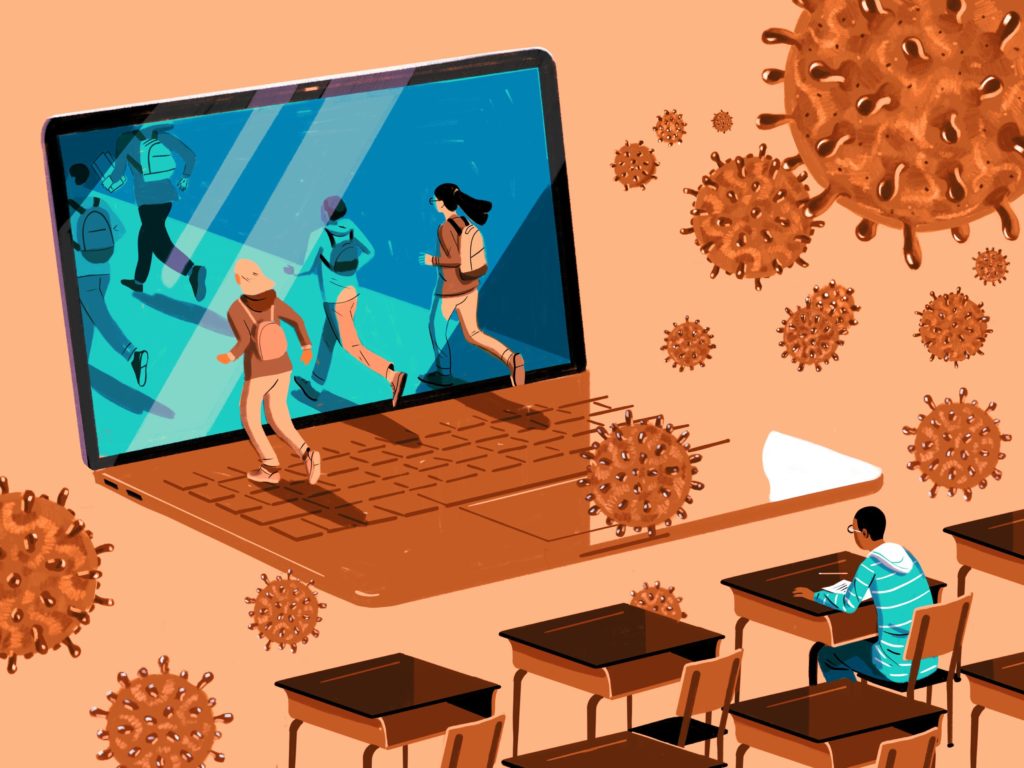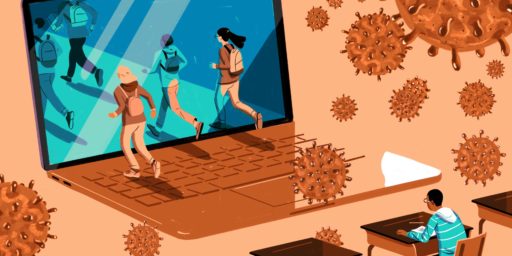Pediatricians Urge In-Person School
Contra the CDC, the AAP says getting kids to class outweighs the modest risk of their catching COVID-19.

The American Association of Pediatricians has put out a statement urging school districts to prioritize getting kids into the classroom full time even at the expense of physical distancing.
NPR (“U.S. Pediatricians Call For In-Person School This Fall“):
The nation’s pediatricians have come out with a strong statement in favor of bringing children back to the classroom this fall wherever and whenever they can do so safely. The American Academy of Pediatrics’ guidance “strongly advocates that all policy considerations for the coming school year should start with a goal of having students physically present in school.”
The guidance says “schools are fundamental to child and adolescent development and well-being.”
The AAP cites “mounting evidence” that transmission of the coronavirus by young children is uncommon, partly because they are less likely to contract it in the first place.
On the other hand, the AAP argues that based on the nation’s experience this spring, remote learning is likely to result in severe learning loss and increased social isolation. Social isolation, in turn, can breed serious social, emotional and health issues: “child and adolescent physical or sexual abuse, substance use, depression, and suicidal ideation.” Furthermore, these impacts will be visited more severely on Black and brown children, as well as low-income children and those with learning disabilities.
There’s quite a bit more both at NPR and in the statement itself.
I think the pediatricians are right here in their cost-benefit assessment but they have an uphill fight. While they’re the experts on overall health of children, most of them aren’t epidemiologists. The CDC guidelines still recommend students be kept six feet apart, which simply can’t happen in conjunction with normal school schedules.
Beyond that, the teachers unions are balking at going back to the classroom at all. A substantial number of their members are elderly or immunocompromised and would definitely be at risk under anything like a “normal” school day. And asking them to teach every day in-class and also manage students who are learning remotely, whether for medical reasons or out of parental concern, is unreasonable.
Anecdotally, at least, parents are torn. The ones I’ve talked to and most of the reactions I’ve read here in Northern Virginia are mostly outraged that the schools, which failed us miserably when they shifted to remote learning in March, aren’t going back to full schedules. But I’ve read accounts of parent-led protests in other parts of the country demanding that schools not re-open until there’s a vaccine.
Of course, parents were also demanding that the schools hurry up and shut down while administrators were wrestling with the issue back in March. But we have a lot more information now, both about the difficulties of remote learning for young children and about the way the disease spreads.
Additionally, I think our mindset—certainly, my mindset—in March was that we needed to make a concerted but relatively brief effort to “flatten the curve.” Everything I was reading indicated that the prudent thing to do was shut schools for a few weeks to get the virus under control and then re-open with proper cleaning and safety procedures.
Now, the inertia has shifted in the other direction. Instead of wrestling with the responsibility of depriving kids and their parents of the support structure of the schools, they’re now wrestling with the responsibility of ordering a return to something like normal.
This would all be easier, of course, if Americans could trust their leadership at the national level. With the President and his enablers fighting against simple measures like wearing masks and conducting testing—and, frankly, the CDC committing multiple blunders as well as lying to us for months about masks—we don’t have that. Which means decisions are all devolving to governors and school boards, most of whom are elected with much less scrutiny than we apply to presidential contests.






Almost. What we needed to do was to make a concerted effort to crush the curve by shutting everything except food down for the several weeks necessary to break the chain of transmission. That would have been painful, but in the end not nearly as painful as months of half-assed semi-shutdowns.
Unfortunately, we have learned that Americans don’t do “concerted” any more, apparently because Freedom. And our politicians won’t force them to do “concerted”, because elections. So we get lingering pandemic, and even the Italians can laugh at our level of disorganization. Pathetic.
We don’t get to have zero risk so we need to have an analysis of risk vs reward. The reward of going back to school is pretty obvious for the kids but is also a positive for their parents and the economy. What we needed was a good analysis of the risk. From nearly the beginning of the Covid outbreak we have known that children seem less likely to contract the disease and are less affected. What wasn’t clear was their role as vectors. I have not read all the studies but if it is pretty clear that they are not significant vectors then weighed against the advantages of going back I think that is a pretty reasonable choice.
That said, I fully expect some parents to make the choice to not have their child go back to school. The risk is not zero. Parents are going to have to determine what level of risk they are going to accept and which downside is a bigger issue for them. You are telling mothers they have to choose between a tiny, tiny chance of illness leading to death vs a larger chance of emotional illness maybe leading to drug abuse and/or suicide. Glad I dont have to decide that as my kids are older.
Steve
Teachers are also likely to view this, “The AAP cites “mounting evidence” that transmission of the coronavirus by young children is uncommon, partly because they are less likely to contract it in the first place,” with skepticism. One doesn’t have to have 20 years of experience in teaching to have witnessed any number of viral infections sweep thru their classes and inevitably infect them. It happens every year.
They also don’t need to be lectured on, “Social isolation, in turn, can breed serious social, emotional and health issues: “child and adolescent physical or sexual abuse, substance use, depression, and suicidal ideation.”” because they are the front line workers on these problems and make heroic efforts every day to ameliorate them as best they can. They are also well aware that “these impacts will be visited more severely on Black and brown children, as well as low-income children and those with learning disabilities.”
As the brother and friend of a number of teachers, I know they (mostly) want to get back in the classroom. At the same time they don’t want to get CoVid, not just for their own sake but for the sake of their families.
I also want to ask what ages define the “young children” for whom there is “mounting evidence” that transmission is uncommon. 5-8? 5-10? 12? Somehow or other I don’t think 16/17 yos are in that group and yet we as a society will want a “one size fits all” policy for all schools.
@OzarkHillbilly:
The large school district where we live has decided that preK through 5th grades will resume full-time in-person school this fall. They’re delaying their decision on the older kids. I suspect that short of a breakthrough, the oldest kids will be largely online, and the middle-school group on some sort of shortened in-person schedule.
I’m glad I don’t have to navigate this decision. I feel for parents, kids, and teachers.
So much of this will be guided by individual situations. For example:
I have one friend who is a teacher for elementary grades. She is immune compromised and is frankly terrified at the idea of going back to the classroom. She teaches in a school with a very high proportion of free and reduced lunch students–and those students are the ones with parents in low-wage jobs that are proving to be highest risk for transmission. She is far too young to retire, and doesn’t know what she’s going to do.
I have another friend with three school-aged children, all in different grades. One of her kids has cerebral palsy, making that child very high-risk. She has no good options–either she does a crash-course in home schooling of all three, or she sends all three to school. There’s no point in just homeschooling the highest-risk child, because the ones who attend school are just as likely to bring something home.
Both of these families are literally having to make decisions that could mean life or death for a member.
@Michael Cain: Thanx.
Two points.
One, I waited tables for years, and cleaned homes and offices for a year plus, and was never sick. My hands, in stranger’s toilets, not sick. Once we had kids going to school I was sick at least once a year.
Two, in grammar school I learned to read and do simple math. In middle school I learned nothing more. And in my two years of high school, again, nothing more. 10 years, thousands of miserable hours, and I came away knowing what I already knew by the third year.
IMHO, schools are a huge disease vector and are generally wasting about 75% of kid’s time. I would keep mine home except that in a miracle of good timing, they live on their own.
I would take a spin similar to Reynolds on this one– This is the perfect pause to ask ourselves “What is school for?” & “What should it be for?”.
We have a model of schooling built for children of the 19th & 20th Century. If we operated under the restraint that School cannot be for socialization–that we can do other things in other forums to socialize our children, what’s left?
Frankly, I believe isolation would be a beneficial stimulus for ALOT of people today–not just the kids. If the pandemic has taught us anything…its that people have no idea how to be comfortable in their own skins or how to entertain themselves–a skill Im sure people of 19th/20th centuries possessed an overflow of. For them, socialization was the enhancement that provided benefit.
I believe that paradigm is now completely flipped on its head.
My little town/county has the following statistics
Total cases: 177, with 103 listed as “active”
By age:
19 and under: 20 cases / 50-59: 20
20-29: 31/ 60-69: 25
30-39: 39/ 70-79: 11
40-49: 28/ 80 : 3
ETA: The above had been formatted to two columns, Sorry 🙁
Two observations: 1) Considering that our population is 105,000, we’ve been pretty lucky, but that 105,ooo are spread over ~1200 sq. mi. which may be a key to our relatively low infection rate.
2) The distribution of infection here is not screaming “OPEN THE SCHOOLS GODDAMMIT!” to me. YMMV
@OzarkHillbilly: Uhhh… yeah… [sigh]
@Michael Reynolds: At the other extreme, I wound up with an MS in an applied math field and was still learning new math when I finished up a 25-year technical career. I have no idea how to separate out Mr. Reynolds, who had learned all the math he would ever need in elementary school, and Mr. Cain, who never reached the point where he knew all the math he needed. I am retired now, but have been charged by my son and his girlfriend with building some gadgetry and I’m having to learn more math.
I would consider (with sending kids back to school), when my pediatrician assures me that it is perfectly safe to do so. (An assurance that I just don’t see forthcoming at this time)
@Michael Cain:
But did you need to sit through 200 plus days a year to learn what math you did learn? Or could you have learned just as much, or more, without that investment in time, not to mention the cost of teachers, administrators, the physical plant, the commuting costs, etc?
As @Jim Brown 32: points out, we are working with a very old paradigm. Today I’d argue the primary function of school is babysitting. To the extent it socializes kids, many, perhaps most kids would likely be better off forgoing it. School teaches regimentation, gender separation, seniority, submission to authority, none of which is useful now. The social environment encourages conformity, bullying or acceptance of bullying, ostracism and gossip.
None of this makes sense. We drag kids out of bed way too early, keep them at school way too long, and fill their heads with crap they’d have been better off not learning. (Every single thing I learned in school about history was bullshit). And we motivate learning primarily through fear, with rewards being purely theoretical and pushed off into the future. How is that helpful?
Aside from reading and basic math my takeaways were that all I needed to do was beat tests, avoid bullies and ignore teachers. 95% of usable information I’ve acquired has been post-school, including whatever I know of history, science or interpersonal relationships.
@Michael Reynolds:
But you’re intellectually curious. I’m not sure that’s applicable to all.
After having lived in Germany, I can see both the logic and drawbacks of their system. The logic of it is that kids who are better suited temperamentally to trades are tracked that direction early, into apprenticeships, while those who are more academically inclined go to a college track. Drawbacks are less freedom of choice, less flexibility (harder to switch careers later), and tough on late bloomers.
It’d be nice if the US pedagogical system was better able to actually teach students what they need to know, but I see a lot of roadblocks in getting there. First, there’s a question of what that even means–learning how to make change? Or understanding financial markets? Both are important. Next, there’s the “my child is gifted” syndrome, most parents are unlikely to accept that their child is just an average learner and not destined for greatness. And there are “unlocked potential” cases too–do we miss those kids who genuinely ARE geniuses if we don’t have some kind of formal education system?
Not arguing with you, to be clear. I’ve often thought that it’s a shame that there aren’t different schools that reflect how different kids LEARN. Some are more tactile, some kids are very kinetic and sitting at a desk is a surefire way to kill any initiative they have. But how do we set up a system where they are ready for employment?
Home schooling isn’t the answer either–at least not for everyone. I was once acquainted with a woman who was homeschooling her kids and her grammar and spelling were TERRIBLE. I really wondered how those kids were supposedly benefiting from the situation, it seemed to me that they were likely to be less prepared upon graduating high school than your average fifth grader would be.
@Michael Reynolds: And of course, everyone else in the entire world is exactly identical to you, so your advice is the one true “one size fits all” solution to the question. 😉
@Just nutha ignint cracker:
I don’t have a wide range of test subjects, but my wife came away from all 12 years knowing just what I knew. We have two kids, one who is very smart academically, one more of a free spirit, and both of them graduated from HS knowing almost exactly what we learned: reading and basic math, though one daughter did take math a bit further. My STEM kid basically blew off the last two years of HS and learned from Khan Academy.
@Jen:
I wish I’d had a trade school option for one of my kids. She has the handwriting of a six year-old, but the palate of Gordon Ramsay. (Honestly, it’s freaky.) We looked everywhere in the US for a school where she could cook and paint and throw pots and learn to do things with her hands. Instead she endured four years of being hectored to go to college, go to college, get a degree or you’re a failure. Four years of being belittled and ignored because she would rather build a house than learn to diagram sentences.
I’ll be the first to admit that I don’t have a magic fix. I just know that formal primary education proved almost completely useless to me, my wife and both our kids. That’s 46 years in total of public school, plus my wife’s BA. To teach four people how to read and do long division.
The United Brotherhood of Carpenters and Joiners of America will take her. I never worked with a woman but I did take journeyman upgrade classes with a few. I worked around a number of female electricians and pipefitters. Pretty sure any of the trades would take her if she had the aptitude.
@Jen:
The problem with the US educational system is that the default is go to college and the alternative is ?????????. We need a path made available to kids after they’ve sorted themselves and decided whether college is the right choice or not. Apprenticeship programs are rare in the US and by and large even industrial trades are taught in a college-like setting.
There’s a great book from a few years ago, Shop Class as Soul Craft by Matthew Crawford that I’d recommend to any parent who has a child that’s not fitting into the traditional college paradigm and also to young adults who followed the go to college mantra and are now miserable in what they are doing.
The problem is that even if the AAP is technically correct, too many parents on both sides of the political isle are scared to get back to normal at least as far as their child’s education is concerned given the recent news regarding the Pandemic.
What we need is a President that instead of getting off on someone in his campaign superimposing his head on Bill Pullman’s during the big rallying moment speech in Independence Day decides to step up to actually give such a speech to the American public. He could have Betsy DeVos and others standing near him (almost said at his side, but social distancing is important to follow) while he declares that in consultation with Betsy and other members of his cabinet he has put together a comprehensive plan to make classrooms safe to return to, and this is just the first part of a multi-step process/plan that will ease us into a new normal.
It could be a truly glorious speech that rallies America and gets us all to seriously take steps to mitigate getting Covid 19 as we get back to going about our days as we have in the past but with some slight modifications to our daily routines/habits.
Such a lost opportunity, Trump let his moment to be a leader in getting kids to go back to school/college pass him by.
BWAHAHAHAHAHAHAHAHAHAHAHAHAHAHAHAHAHA…. gasp…. wheeze…. What a joker you are. 😉
For many working families there won’t be an actual choice as school is the main form of childcare while parents work. Add in that additional care is often provided by grandparents, I don’t think a blanket opening of regular school is a good idea, but if parents are forced to work, what would be the alternative.